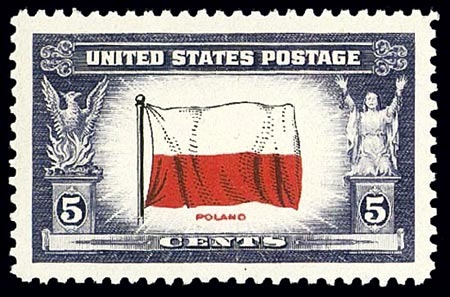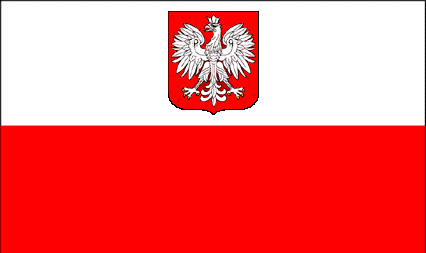
U.S. #909
5˘ Flag of Poland
Overrun Countries Series
Issue Date: June 22, 1943
City: Washington, D.C.; Chicago, IL
Quantity: 19,999,646
Printed by: American Bank Note Company
Printing Method: Flat-Plate
Perforations: 12
Color: Blue Violet, Red, and Black
U.S. #909 is part of the Overrun Countries Series, which honors each of the nations invaded by Axis powers during World War II. It pictures the flag of Poland, which features red and white bars, the national colors since 1831.
Poland History
Poland has a long and varied history. At one time, Poland ruled an empire that stretched across much of central Europe. In 1795, Poland was conquered and divided among Russia, Germany, and Austria. This brought an end to Poland’s centuries-old existence as a separate nation. The Poles fought with Austria against the Russians in World War I. In 1917, a Polish National Committee was formed in Paris to win allied support for an independent Poland. Under the 1919 Treaty in Versailles, Poland regained large amounts of land from Germany. In 1921, the Russian Treaty of Riga established a border that gave back some of the Russian territory. The new Polish state faced many problems, but during the 1920s and 1930s, Poland slowly rebuilt its economy and developed uniform systems of government, transportation, and education.
During World War II, postponed mobilization of Poland’s troops left the nation unable to withstand the overwhelming German forces. They were invaded on September 1, 1939. Warsaw, although severely bombed, defended itself heroically until September 27. In 1941, Germany seized all of Poland and a Polish government in exile was formed in London. However, by 1948, Communist rule was firmly established.
These Stamps Brought Hope to Overrun Countries of WW II
After receiving several designs from artists who felt the current U.S. postage stamps were unattractive, President Franklin Roosevelt began to consider the types of stamps he wanted to issue. He sought to show the world that America was in this war to achieve world peace, not military dominance. With this in mind, the President suggested the U.S. issue a series of stamps picturing the flags of all the overrun nations in Europe.
In the border surrounding each flag, Roosevelt suggested picturing the Phoenix – an ancient symbol of rebirth. He believed “It might tell those suffering victims in Europe that we are struggling for their own regeneration.” The other side of each flag pictured a kneeling woman “breaking the shackles of oppression.”
When the time came to print the stamps, the Bureau of Engraving and Printing was unable to print the multiple colors needed for each flag, so the American Bank Note Company received a special contract for this series.
Additionally, a 5˘ denomination – the foreign rate for first class postage – was chosen so the stamps could be used on overseas mail.
The stamps were printed in relatively small quantities and were in high demand as soon as they were issued, with stocks across the country running out almost as soon as they were released.
FDR – The Stamp-Collecting President
President Franklin Roosevelt was instrumental in the design and issuance of U.S. #909. Introduced to stamp collecting at a young age by his mother, Franklin Delano Roosevelt turned to his collection throughout his life to relax and unwind.
Elected President four times, Roosevelt served in the nation’s highest office longer than any other chief executive – 12 years. During those 12 years, Roosevelt shared his love of stamps with the nation, personally approving each of more than 200 stamp designs. He suggested topics, rejected others, and even designed some himself. It was his aim to use stamps not just to send mail but also to educate Americans about our history. And as he reluctantly entered America into World War II, he saw these stamps as an outlet to raise spirits and bring hope.

